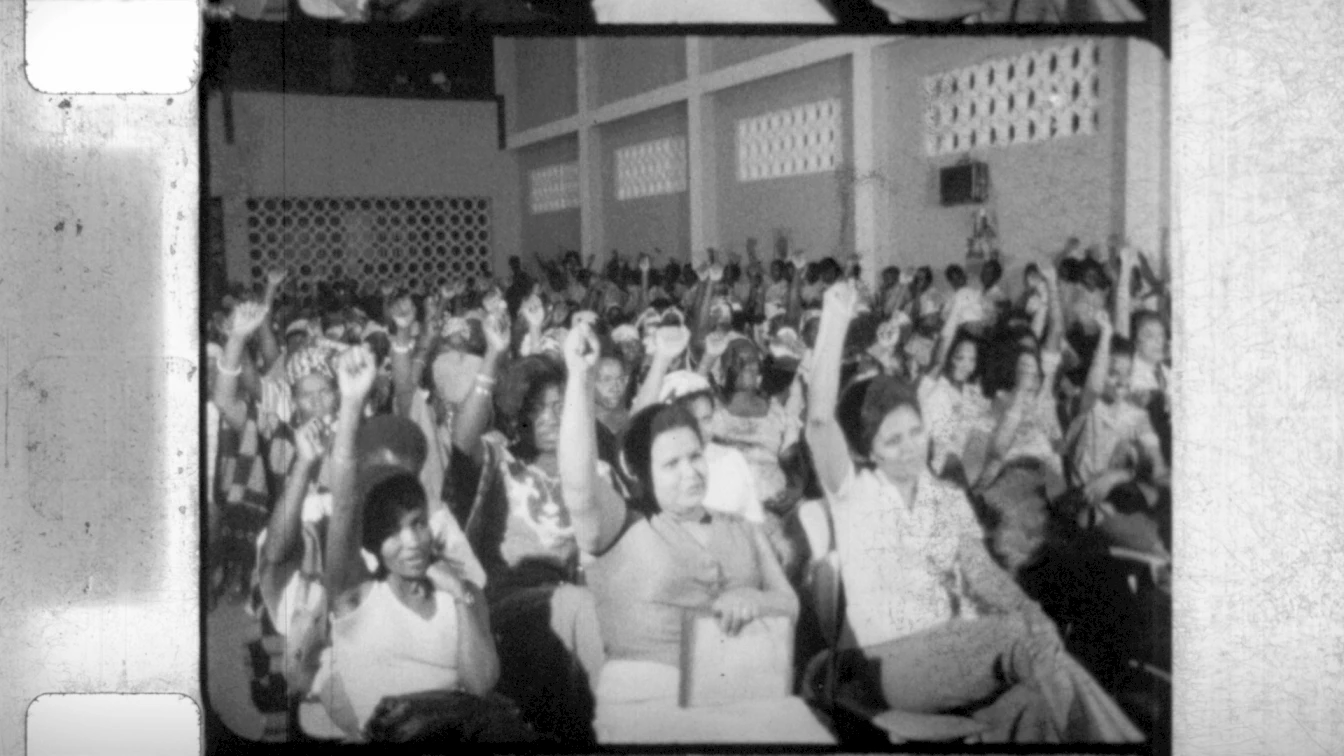
Footage for unfinished film about Guinean women. Labels on the reels: women at work, women at school, women in politics, women mother, farming women. INCA, Sana na N’Hada and Flora Gomes, 1979.
What made sense as an object of our propaganda in one particular context, can become a sturdy 'friend' difficult to appease in quite another. It can become an obsession for us to want to control the image that one day we produced accidentally, saying 'that's for history'. [...] Yet the image gives itself a new life, a new destiny, with or without us. It frees itself of our guardianship.
(Sana na N'Hada, Our image and ourselves, 2015)
"Well, I have no good news. It seems Chris has played one last prank on us".1 These were Anita's first words to me when I arrived at her apartment. The box with the Bissau documents was on the table – letters, pictures and journals damaged after recent flooding in the attic. "Maybe you just have to photograph Courgette (the cat) sitting on top of it – that would say it all". Sunday 29 November 2015, I visited the French writer and filmmaker Anita Fernandez, to greet a dear friend and photograph some documents that she keeps from her experience in Guinea Bissau in 1980. This was one of the last stops on the journey of the Luta ca caba inda (The Struggle is Not Over Yet) project which has spanned decades through Paris, Boé, Berlin, Bissau, Guimarães, Conakry, Moscow, Cuba, Cacheu, London, Lisbon.
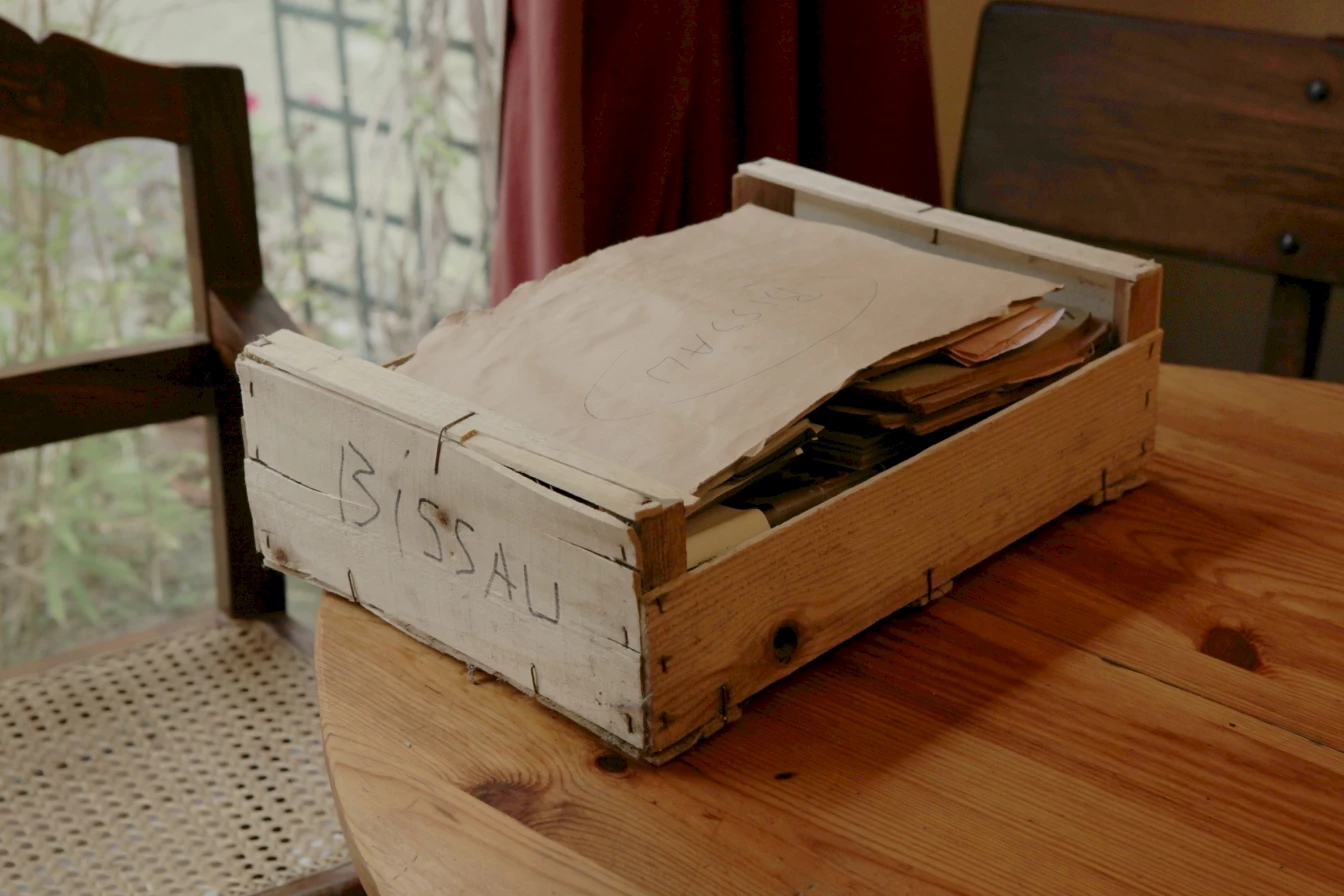
Box with documents at Anita Fernandez's place. Photograph by Filipa César, 2015.
SUNLESS
I first met Anita Fernandez in 2012 after an event at the Jeu de Paume cinema, presenting freshly digitised materials from the Guinean audiovisual archive. Fernandez came to re-encounter her old friend Sana na N'Hada, one of the four pioneers of Guinean militant cinema. Among many other young Guineans sent to Cuba in 1967 to be educated in various disciplines (mainly medicine, warfare and aviation), N'Hada was to be trained in the field of cinema and joined Santiago Alvarez's team at the Instituto Cubano del Arte e Industria Cinematográficos (ICAIC) in Havana.
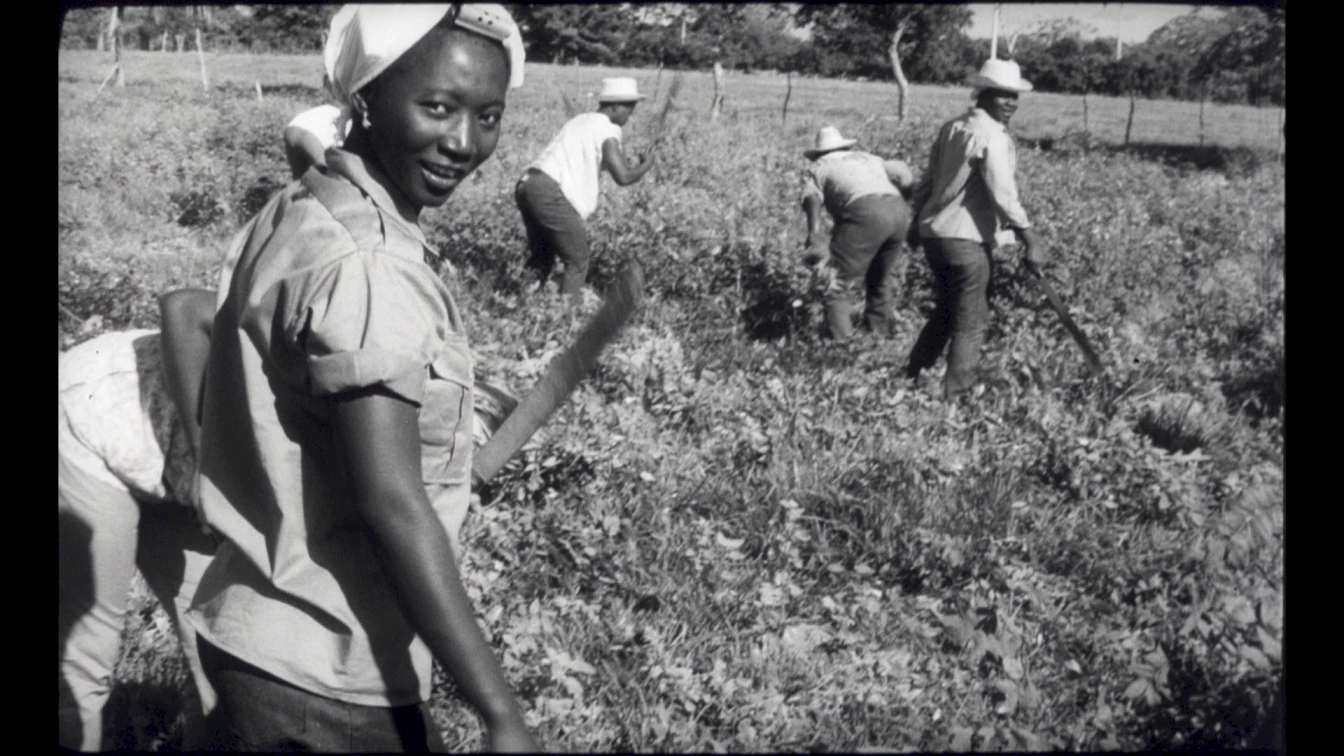
Voluntary work by Guinean students in Cuba. Sana na N’hada comments on these images – all four young filmmakers can be seen with a machete in their hands cutting couch grass, the aim of the voluntary work was to teach humbleness. Humility, fit on the ground, close to the soil, humble derives from humus. INCA, Dervis Spinoza, 1967.
My involvement in the long-term collective project Luta ca caba inda was less dependent on my curiosity for these cinematic genres, but rather unintentionally, the result of a suction force, pulling me into the magnetic field of a web of conditions, urgencies and magical encounters. The Portuguese colonial war, despite ending just before my birth in 1975, was a latent presence in my childhood, casting shadows of fear, subversion and cryptic intensities. My father was the channel, after his failed desertion to Paris, he had served in the military in Portuguese Guinea between 1967 and 1969. I was introduced to an imagery of resistance to Salazar's regime – underground subversive political literature, the illegal emigration of deserters and political activists and a revolution through the radio transmission of a coded song. But for many years I thought this was a story disconnected from the rest of the world. Something that resided in my apartment, animated by certain props – a military uniform, blue batik fabric, an African wooden sculpture. A tale, rather than history.
That changed in 2003 when I was bewildered by my first encounter with Sans Soleil by Chris Marker. There were images of Guinea and a spellbinding voice talking about the Portuguese/ Guinean conflict: "Why should so small a country and one so poor interest the world?" – and further – "Who remembers all that? History throws its empty bottles out the window". A French filmmaker knew about that war and also knew that the country inscribed in my fantasy did not interest the world. I knew that Guinea was the place where my father had fought on the wrong side - mistaken by the communist ideals that militants should infiltrate the colonial military and subversively undermine its power - with dignified intentions that didn't prevent him from getting implanted there in a sunless gloom. Happiness is but awareness of misfortune. The stage of the haunted tale became a geopolitical spot – Peter Pan showing up at the window – hey, you can jump with the empty bottles.

Reels from the unfinished film Luta ca caba inda. Photograph by Filipa César, 2012.
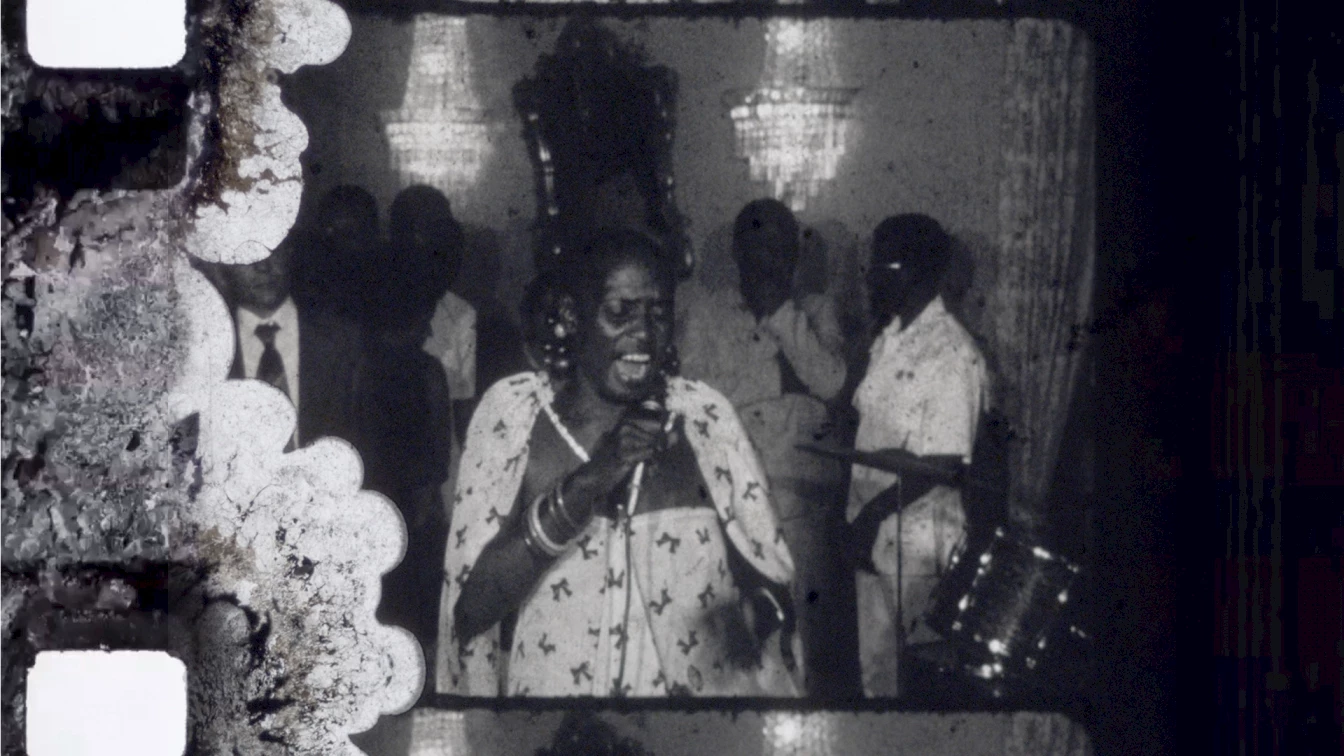
XX Anniversary of the Liberation Party. Miriam Makeba emerges from the film ruin, the force of her embodied Pan Africanism fights the celluloid infection tainted by a neo-colonialist virus. INCA, Sana na N’Hada and Flora Gomes, 1976.
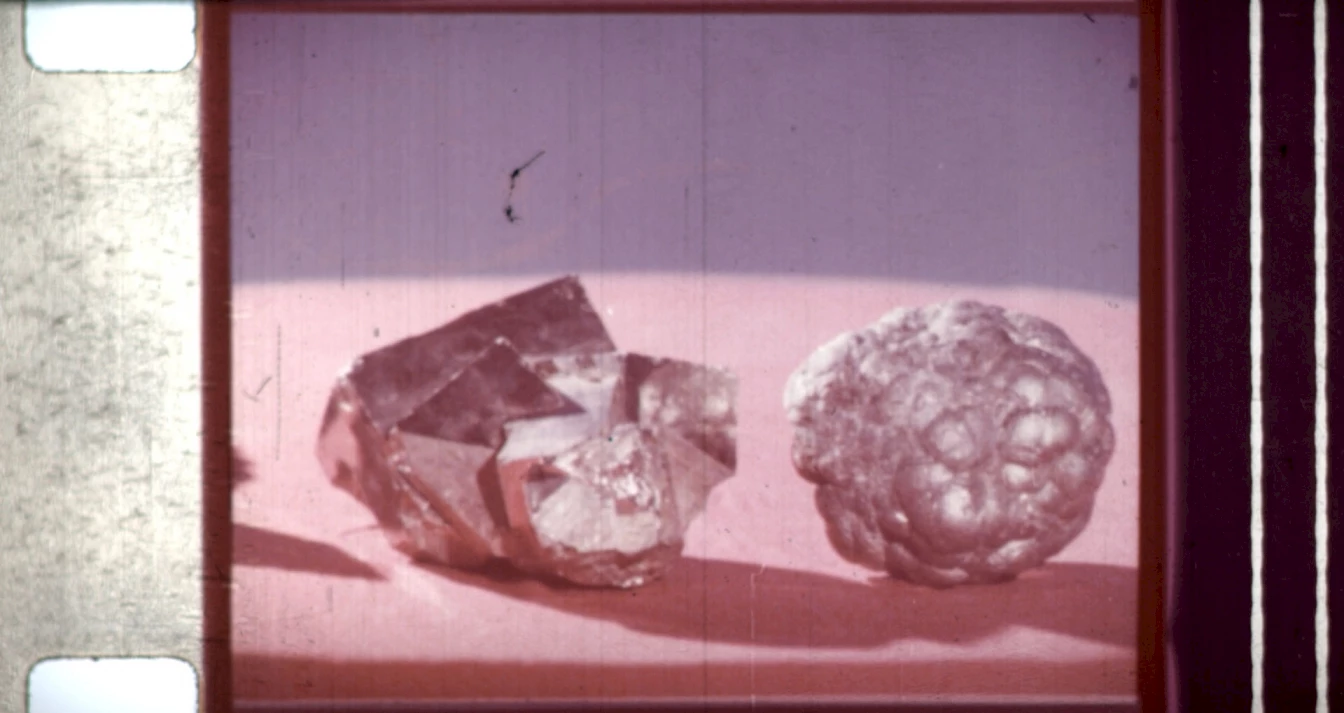
Chinese newsreel: China Today number 8110 – museum display of stones and minerals, title – valuable mineral resources. Found at the INCA archives, Bissau.
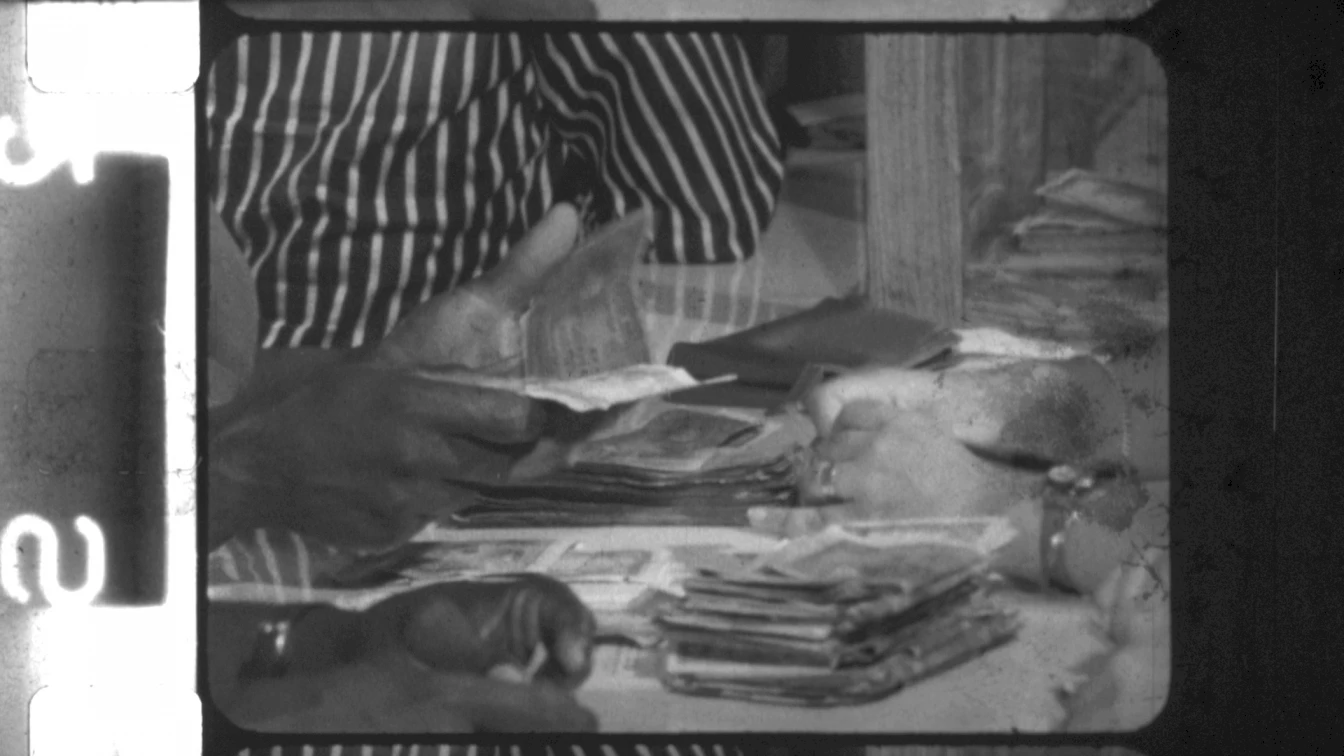
Inside a bank, bank notes, currency exchange process from Portuguese escudos to Guinean Pesos, images of a second emancipation – the financial independence from Portuguese control. INCA, Sana na N’Hada and Flora Gomes, 1976.
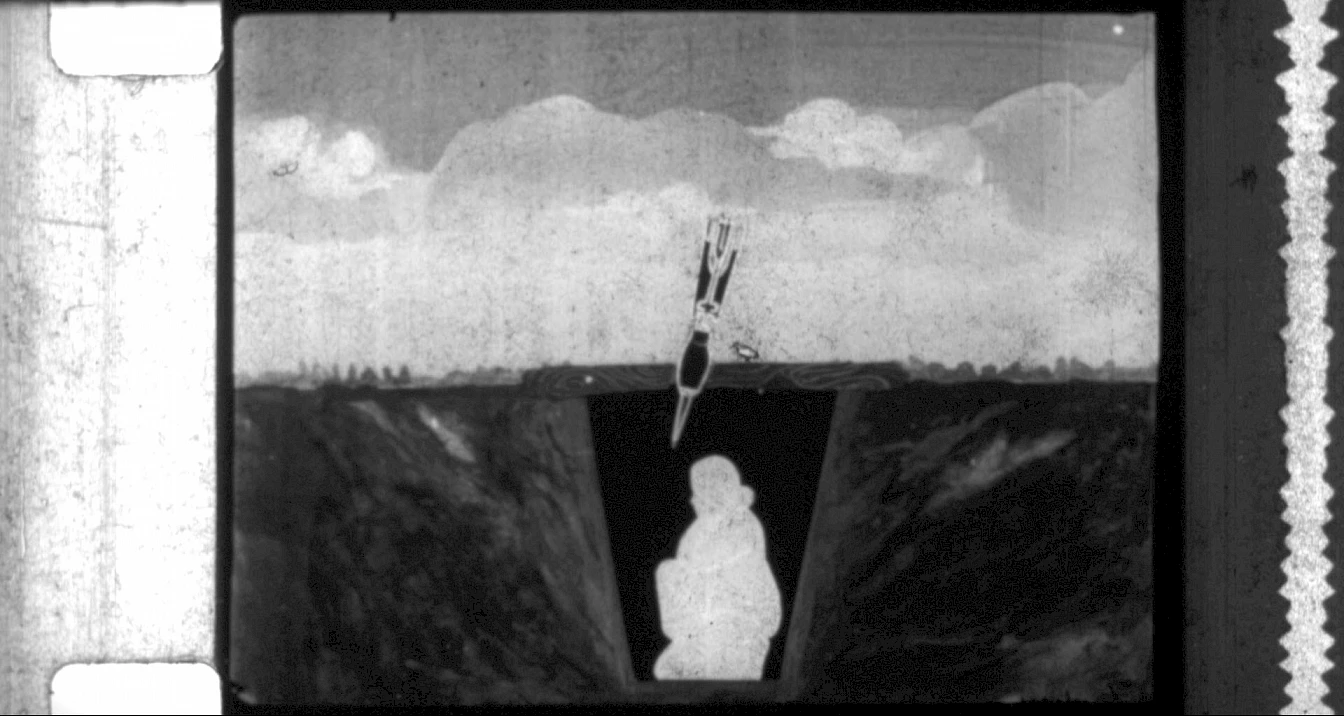
Excerpt of undated anti-Apartheid film, educational film genre, image of various weapons, animated illustrations demonstrating their mechanisms and usages, documentation of corresponding injuries on human bodies. Found at the INCA archives, Bissau.
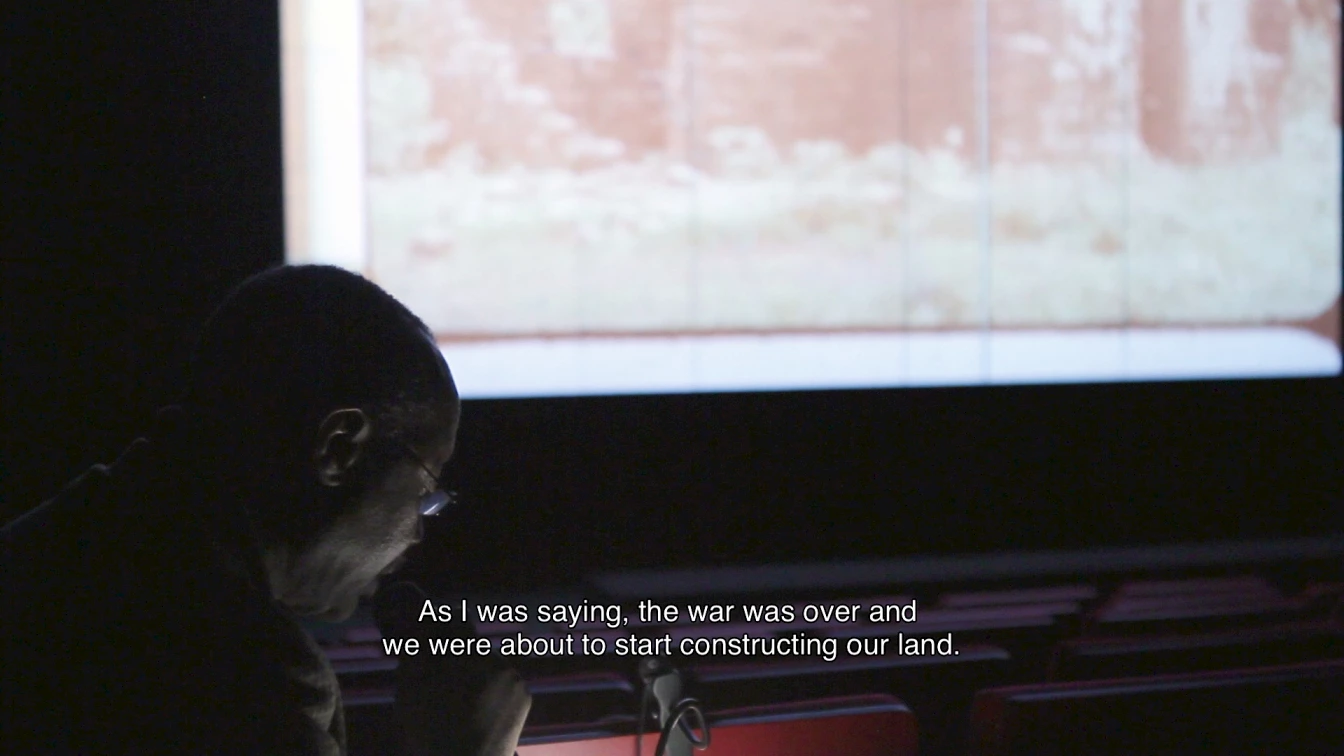
Sana commenting on footage from the unfinished film Guinea-Bissau: 6 anos depois. Arsenal Cinema, Berlin. Image by Nuno da Luz, 2012.
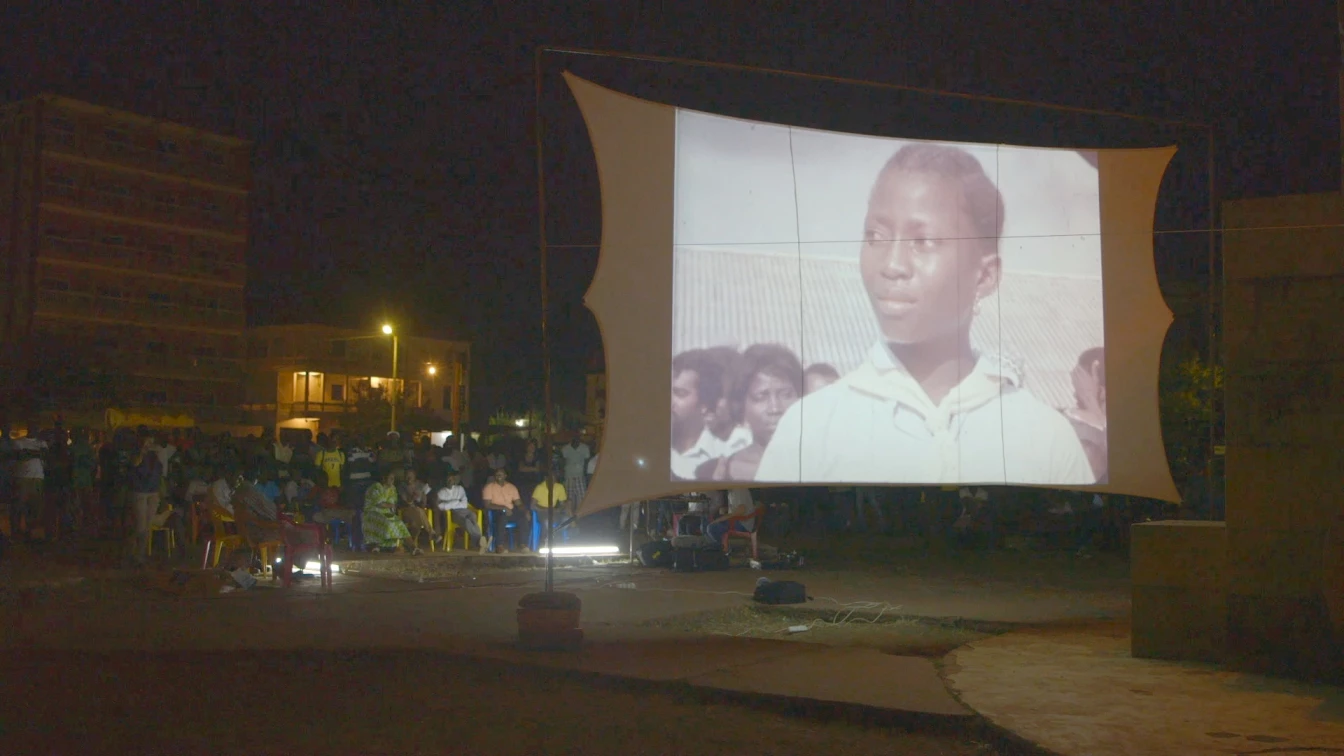
For four weeks in November/December 2014, we toured through GuineaBissau with images and sound from the archive equipped with a simple cine-mobile unit and a seven-members entourage, Sana na N’Hada and I curated a programme for each stop. After the commented screenings, radio broadcaster Aissatu Seidi invited the public to intervene. Image by Jenny Lou Ziegel, 2014.
THE POTENCY OF IRRELEVANCE
In 2009, Colin MacCabe asked me if I would like to accompany him to visit Chris Marker, rue Courat. When asked about Guinea, Marker answered: "If you are interested, then go and meet Sana2". That is how I came to Bissau in January 2011 to meet Sana na N'Hada, Flora Gomes and other people connected with Guinean cinema and literature such as Odete Semedo and Suleimane Biai. They showed me a room full of film canisters in a very wet and gloomy environment at the Institute of Cinema in Bissau. N'Hada told me that this was where their early work as the first Guinean filmmakers was stored, and how he, at the age of seventeen had been picked out from the middle of the jungle war and sent by Amílcar Cabral to Cuba to become a filmmaker – and how he had never seen a film before. N'Hada's preoccupation with the imminent loss of the archive moved me and made me speculate about the promise of a militant cinema of emancipation, born from the struggle as a praxis of liberation and a possible deviation from my own imagery.
Later I got in touch with the Head of archives at the Portuguese Cinematheque. They knew about the Guinean archive, and had even sent dozens of new canisters to Bissau to re-accommodate the films, but for many reasons, also connected with diplomatic tensions and the financial crises, they told me: "the archive is irrelevant". Their arguments were the deeply fragmented and ruined state of the collection, holding mainly unfinished films or unedited footage, and finally most of its reels were eroded copies of foreign films existing in better state in other archives. They were right about everything. Nevertheless that sentence entered a resonance field in my mind.
"The archive is irrelevant" was in direct proportion to "History throws its empty bottles out the window". Wasn't that emptiness for history what fullness was for the subjects out of history? Were those bottles eventually full of the answers to give to "a worker who reads" (Brecht 1995)? A Benjaminian angel staring at ruins (Benjamin 1940/ 2007). Jumping with the empty bottles seemed an historical materialist take, to "contest the colonial archive" (Eshun 2003) through the replacement of a viewpoint, a chance to look at European myopia through the lenses of colonial resistance.
The disquiet latency in the statement "the archive is irrelevant" rendered the strangeness of the repeated sounds of words. Meaning gets lost and words gain in materiality, texture, volume and accident. "Irrelevant" became this rugged matter of rrr, raw, rough, rhythm. Material word-decomposition follows up on etymological break down. The prefix "i" in "irrelevant" is the resistance to relevant – I can visualise the "i" operating on the signifier, relevant both through the shape of "i" as serif font and through the negative meaning, as if a palm-oil press would squeeze the potential salience or elevation of "relevant" back to the ground, close to humus. The double "r" in the word produces the texture of an eroded soil or furrowed field. The sap extracted from that "i" pressing relevant frees the nectar of power and immortality – ambrosia. "Irrelevant" is the becoming mortal, becoming humble3. "Irrelevant" became a word-energy, the frequency and intensity of the non-power. The word performing the gesture of throwing empty bottles out of the window, when meaning is not signification, but rather the very action performed by the signifier (Deleuze & Guattari 1980/2013).
Relevant, re-Levant, where the sun rises again, a Mediterranean land east of Italy. Irrelevant, no-Levant, no rising of the sun, Sunless4.
Etymologically unfolding the word "relevant" – it derives from prominence, distinctness, or vividness due to contrast; the projection of a figure from the ground or plane on which it is formed, as in a sculpture, giving the appearance of a third dimension. Adjectivised, "relevant" means pertinent to the matter at hand, depending upon, helpful, or to lessen, lighten, relating to relieve. The logic of relevance operates within a vertical, hierarchical, power relation system in which relevance always performs the task of sustaining this verticality through imposed stratification. Something is relevant to a system if something assists that system to fulfil a task. "The archive is irrelevant" is spellbound, it also means – this archive does not assist a certain system to achieve a certain goal.
However we were not interested in re-evaluating the relevance of the archive by shifting it into another system where it might become relevant. We were drawn to deal with the potency of that condemnation. The opposite of relevance is not irrelevance, but depression5or fold (Deleuze & Guattari 1980/ 2013). For the Luta ca caba inda operation, we were not searching for an opposition that functioned in the same inverted equation, we were interested in the horizontality, the relational potential of that flattening spell and in the "prosopomorphic"6ability of the material.
The other problem was the reverberation of the word "archive", an irrelevant archive accommodates an intriguing contradiction – archive derives from arkhe, meaning the commencement and commandment (Derrida 1995/ 1996), i.e. the source and beginning of power. "The archive is irrelevant" could mean a collection of never-ending powerless documents, or documents which operate a never-accomplished non-power. What we signposted as material of potency. We wanted to exercise a ritual of profanation of the archive power, stop using the word "archive", to substitute it for collection, materials or assemblage, words of destitute power and collectivism.
During the rainy season of 1999, after the civil war in Guinea Bissau, the audiovisual material stored at the Film Institute was thrown out of the window into the streets of Bissau. Only weeks later the filmmakers themselves (Flora Gomes, Sana na N'Hada and Suleimane Biai) rescued what remained of it, escorting it as they could through years of neo-colonial instability (Nkrumah 1965). Its ruined and fragmented state became a chance – instead of looking at the material as something precious, we thought of it as a moving body, a projectile that we were able to accompany in its flight – an aeronautic drive, a nomadology, an abdication of history.
LUTA CA CABA INDA
Luta ca caba inda is a Creole expression which means "the struggle is not over yet". It is also the title of an unfinished film in the collection, thus cursing the accomplishment of the film, of the struggle, and eventually of this project too. We appropriated the title and its curse for a series of screenings and discursive events used to channel the contents of the fragmentary corpus, and to welcome its conflicts. In this text, "we" always means the Guinean filmmakers and the crowd that built an alliance from the first cataloguing of the materials in Bissau, through the digitisation in Berlin, up to the participation in multiple screenings and discussions in dozens of locations in the past four years. Luta ca caba inda showed itself to us as an irrelevant irreverent force that claims: I am not from yesterday. It is a projectile that is traveling for decades, centuries and offered the chance to join the journey.
The transfer of the film and audio reels onto digital matter was not an action of institutional preservation of the audiovisual material. The experimental digitisation occurred in 2012 in collaboration with the Institute Arsenal for Film and Video Art in Berlin and its copies are held both there and at the National Film and Audiovisual Institute in Bissau. The analogue material was sent back to Bissau in January 2013. Facing an otherwise irrelevant archive, we had to create our own techniques, rules, ethics and praxis as "new archivists" (Derrida 1995/1996). The digitisation of the archive was a process of documenting our passage through that audiovisual matter – a dated molecular transfer. There was no attempt at restoring the material to any hypothetical original state7. None of these words – recovering, restoring, preserving – apply to Luta ca caba inda, which is about film materials as agents of today. Tobias Hering wrote: "This archive smells of vinegar, not ashes. It is not grey. It is white, hazy blue, pale green and a well-known sepia tone" (2012). The fungus, the vinegar syndrome, the scratches, the dust, the absence left by the damaged emulsion on the celluloid reels are part of the aggregation of matter that produces an image – "disease is the evidence of relation" (Haraway 2003). These are no representations of the past, only matters of the present. We stopped calling it an archive and instead a collective milieu, an assemblage of shrapnel. To deal with the shrapnel of colonialism means to deal with all the violence that comes through it; it means embracing the conflicts related with a permanent "decolonisation of thinking" (Viveiros de Castro 2012) as a condition and as a never-accomplishable task.
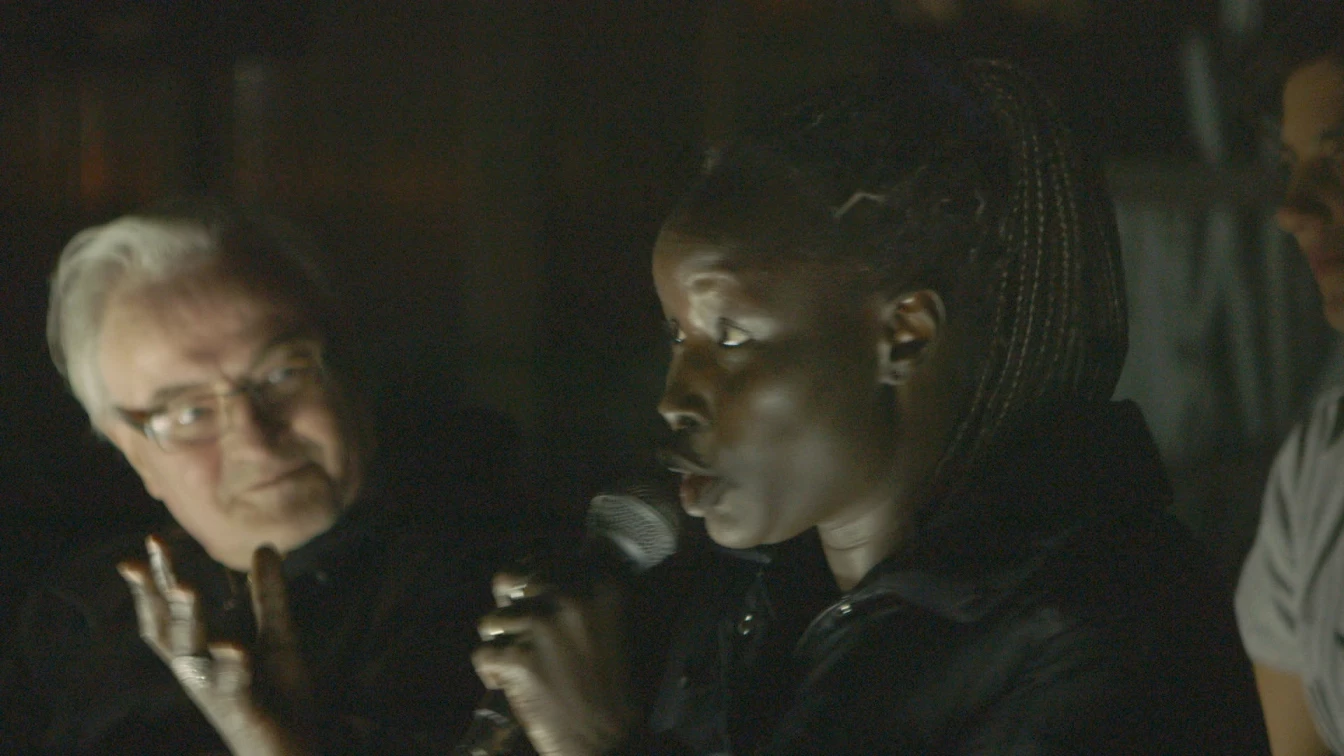
Refugee and human rights activist Napuli Paul Langa and Lennart Malmer at Visionary Archive Festival, Berlin. Image by Jenny Lou Ziegel, 2015.
IMAGES & SOUNDS AS PRESENT MATTER
War is not only channeled through the representations in the image but also inscribed in the material condition of its support media. War wreckage and fractalisation used to look through and access a crystallised time, a lens that can reach a certain surface in contemporaneity and beyond – one not graspable to the naked eye. A kaleidoscope resulting from destruction – but also from resistance and alliance – as the becoming of multiple visibilities. The operation of relevant works at the antipodes of the structure of the poetry of the haiku. In a haiku, sentences are placed in relation to each other, but they don't need to have a cause and effect link between them, they don't have to be relevant to each other – and yet they affect each other, they co-exist in the possibilities of aimless relation. The magnetism of the sessions activated with Luta ca caba inda produced an inversion too – the archive started to grow instead of shrink8. In order to communicate some sense of the work made with these materials, and because it is impossible to condense the mutilated body constituting this collection into a comprehensive description here, a documentation of this cine-geography (Eshun & Gray 2011) and its activation is included in the attendant images and captions.

Sana na N’Hada, Jean Pierre Bekolo and Nuno Faria at 4th Encounters Beyond History: An Archive in Relation, Guimarães. Photograph by CIAJG, 2015.
FLASCHENPOST
Back to that November in 2015, rue des Maraîchers – 550 Google-meters away from Chris Marker's place. I wanted to photograph a couple of documents that Anita Fernandez had presented during a screening in Berlin in 2013. Two documents held particular accounts of this threat between Marker's engaged cinematic praxis and the Guinean militant cinema:
– A postcard from Paris dated 23 June 1980: the back was the Eiffel Tower photographed through a fisheye lens. It was handwritten with comic-like onomatopoeic signs addressed to Anita Fernandez in Bissau (via Dakar). Anita unraveled Marker's postcard by recalling that early in 1980, Marker had asked her for a meeting. For one hour in a Parisian café, Marker spoke fast slurred words that Anita couldn't decode entirely, ending with: "You agree?" Anita was so taken by Marker's enthusiasm that she answered: "I didn't understand what you just said, but I agree". Marker was asking her to go to Bissau and continue his work helping to develop the recently founded National Film Institute and a cinema praxis with the young Guinean filmmakers.9
– A letter from Chris Marker in Paris to Anita Fernandez in Bissau dating 19 May 1980: "You can imagine how happy I was by reading your letter (just followed by another from Sana who confirmed the progress accomplished from his point of view – this produced an interesting stereo-euphoria in me). It is certain that the first obstacle has been overcome. There will be others, but that was truly the most difficult one to solve – that of, to do or not to do. [...] The problem is now 'what next?' or more exactly 'who next?' [...] I have volunteers, but generally more enthusiasts than experts – and among the experts, I have to admit that not everybody has kept the militant fiber. [...] (But eventually I'll go to Japan again, where the unattended elections will take place in June: if I'm not there, Sarah [Maldoror] can respond, therefore also send her the information – doubly. Greet everyone, particularly the cats of the September 24".

Postcard from Chris Marker, June 1980 after flooding in Fernandez’s place in 2015. Anita Fernandez' private archives.
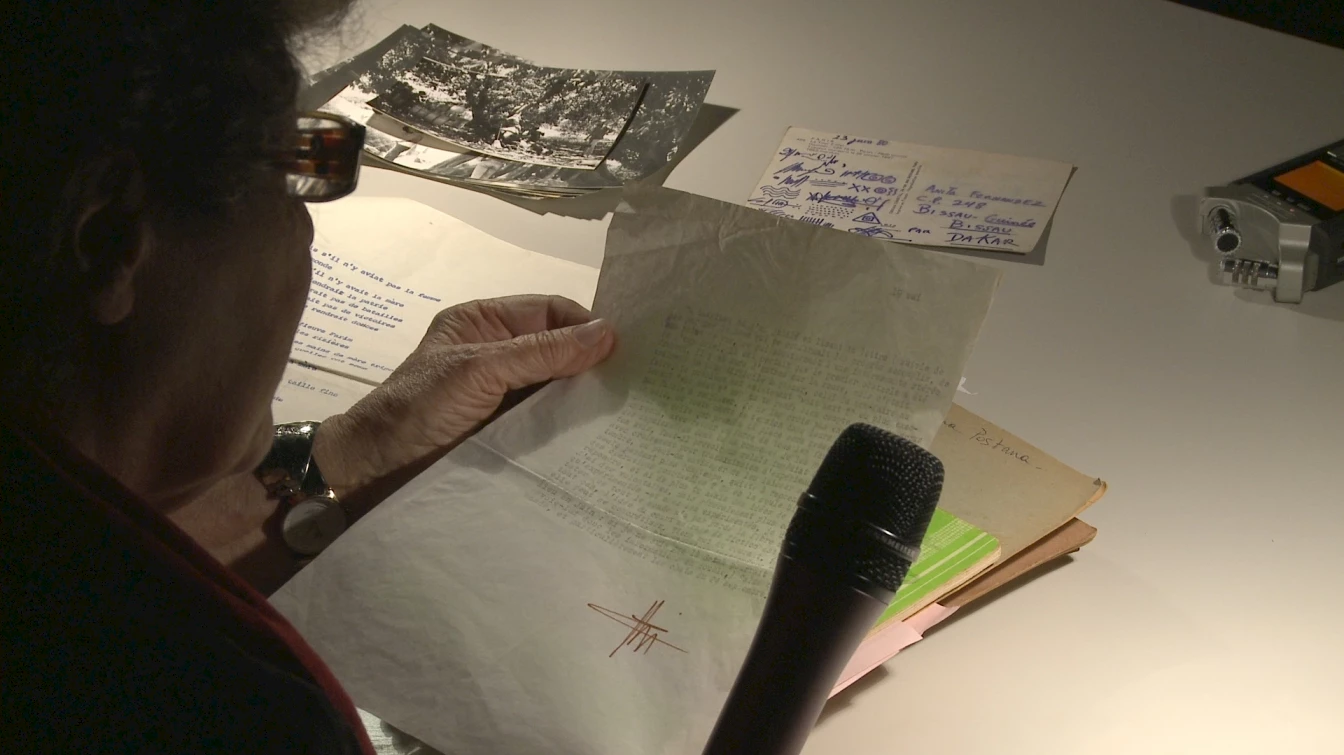
Anita Fernandez reading a letter from Chris Marker, Arsenal Cinema, Berlin. Image by Filipa César, 2013.
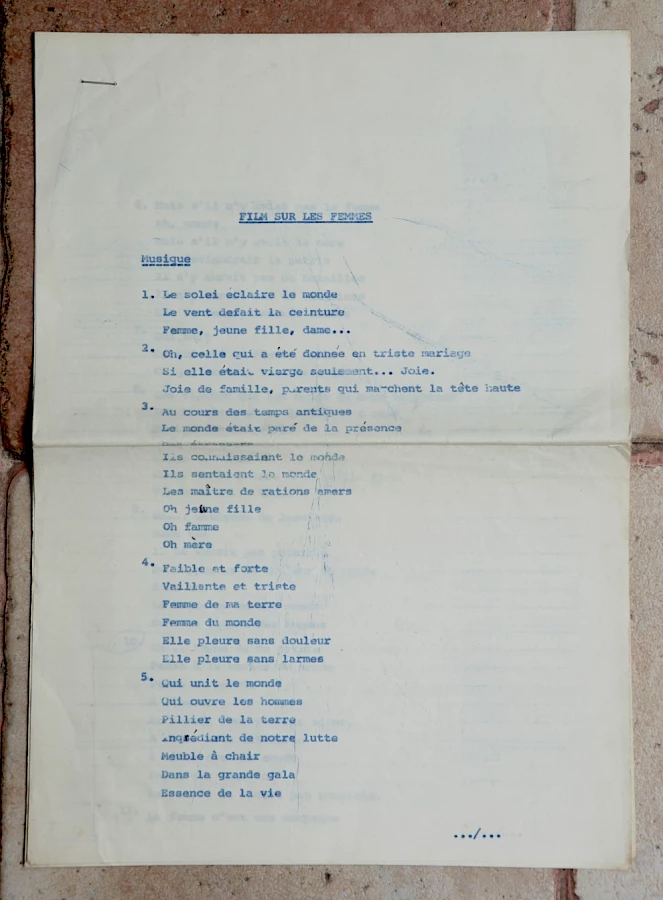
Carbon copy of the lost script for the Guinean film about women. Anita Fernandez' private archives.
When Anita told me that precisely those two documents were damaged, I thought about the gesture of the thrown bottles. Theodor W. Adorno's Flaschenpost, full of messages circulating in the underground, irrelevant, waiting to be found after a flood of Black Atlantic (Gilroy 1993) waters. A latent force resisted the grabbing, comprehending or fixing of these accounts. A chance to merge with the uncertainty of a temporary flight, to draw the line into a never-to-be-reached-point. Dribbling historical narrative into a multitude of untraceable encounters.
Marker's epistolary remnants and analogous pranks prefaced many of the trajectories of the Luta ca caba inda project. The conflict with interference – to do or not to do. The problem of keeping the flame of militancy. This archive is defiantly irrelevant for the purposes of history writing, instead it expands a space to connect, discuss, and tangle a web of empathies, kinships (Haraway 2015) and cine-families.10 Marker was pointing at flying empty bottles full of spectres of solidarity, subversive practices and other cocktails.
After photographing the faded documents, I packed everything into the Bissau box. I moved towards Anita cooking us lunch, and when I looked back, Courgette the cat, was just making himself comfortable on top of the box, like a pilot preparing for take-off.
References:
Adorno, T.W, 1951/1974, Minima Moralia: Reflections from a damaged life, New Left Books, New York.
Barthes, R. 1966/1982, The Empire of Signs, Hill and Wang, The Noonday Press, New York.
Benjamin, W. 1940/2007, "Theses of the Philosophy of History", Illuminations. Essays and Reflections, Schocken Books, New York.
Brecht, B. 1995, Plays, Poetry and Prose, Journals 1934–1955, Routledge, New York.
Daney, S. 1994/2007, Postcards from the Cinema, Berg, New York.
Deleuze, G. and Guatarri F. 1980/2013, A Thousand Plateaus, Bloomsbury Academic, London and New York.
Deleuze, G. 1988, Foucault, University of Minnesota Press, Minneapolis.
Derrida, J. 1995/1996, Archival Fever: A Freudian Impression, The University of Chicago Press, Chicago.
Didi-Huberman, G., and Ebeling, K. 2007, Das Archiv brennt, Kulturverlag Kadmos Berlin, Berlin.
Eshun, K. 2003, "Further Considerations on Afrofuturism", The New Centennial Review, Summer.
Eshun, K. and Gray, R., 2011, "The Militant Image, a Ciné-Geography", Third Text, no. 108, vol. 25, no. 1, January, London.
Gilroy, P. 1993, The Black Atlantic: Modernity and Double Consciousness, Harvard University Press, Cambridge.
Glissant, E. 1990/2010, Poetics of Relation, Ann Arbor, The University of Michigan Press.
Haraway, D. 2003, The Companion Species Manifesto. Dogs, People and Significant Otherness, Prickly Paradigm Press, Chicago.
Haraway, D. 2015, "Anthropocene, Capitalocene, Plantationocene, Chthulucene: Making Kin", Environmental Humanities, vol. 6, 2015, pp. 159–165.
Hering, T. 2012, "Before Six Years After", in La Lutte n'est pas finie, Filipa César, Jeu de Paume, Paris.
MacCabe, C. 2012, "Visites rue Courat", Trafic, no. 82, December, Paris.
Melitopoulus, A. and Lazzarato, M., Viveiros de Castro, E. 2012, "Assemblages: Félix Guattari and Machinic Animism", e-flux journal, no. 36, July, viewed 1 February 2016, e-flux.com.
N'Hada, S. 2015, Our Image and Ourselves, unpublished.
Nkrumah, K. 1965, Neo-Colonialism – The Last Stage of Imperialism, Thomas Nelson & Sons, Ltd., London.
Viveiros de Castro, E. 2012, Cosmological Perspectivism in Amazonia and Elsewhere, HAU Network of Ethnographic Theory, Manchester.